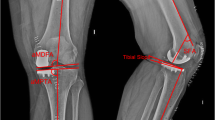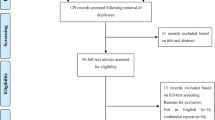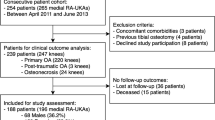Abstract
There is a high prevalence of knee osteoarthritis that affects only the medial tibiofemoral compartment. In this group of patients with severe disease, the medial unicompartmental knee arthroplasty (UKA) is an excellent choice. However, this technique has a great learning curve due to the lower tolerance of improper positioning and alignment. In this context, the robotic-assisted surgery (RAS) arises as an option to improve the accuracy and secondarily enhance the clinical outcomes related to the UKA. The objective in this study is to determine if there are significant advantages with the use of RAS over conventional surgery (CS). In the systematic review of the literature, classification of the results in three main subjects: (A) precision and alignment; (B) functional results and clinical parameters; (C) survivorship. We found 272 studies, of which 15 meet the inclusion and exclusion criteria. There is mostly described that RAS significantly improves the accuracy in position (80–100% of planned versus performed P < 0.05), alignment (2–3 times less error variance P < 0.05) and selection of the proper size of the implants (69.23% of correct size femoral implants versus 16.67% using CS P < 0.0154). Recently, there is mild evidence about benefits in the early rehabilitation and post-operative pain, but in all studies reviewed, there is no advantages of RAS in the long-term functional evaluation. There is no strong literature that supports a longer survival of the prothesis with RAS, being the longest mean follow-up reported of 29.6 months. RAS is a useful tool in increasing the precision of the medial UKA implant placement. However, there is still a lack of evidence that properly correlates this improvement in accuracy with better clinical, functional and survival results.

Similar content being viewed by others
Availability of data and materials
Yes.
References
Lawrence RC, Felson DT, Helmick CG et al (2008) Estimates of the prevalence of arthritis and other rheumatic conditions in the United States. Part II Arthritis Rheum 58(1):26–35
Vos T, Flaxman AD, Naghavi M et al (2012) Years lived with disability (YLDs) for 1160 sequelae of 289 diseases and injuries 1990–2010: a systematic analysis for the Global Burden of Disease Study 2010. Lancet 380(9859):2163–2196
Bijlsma JW, Berenbaum F, Lafeber FP (2011) Osteoarthritis: an update with relevance for clinical practice. Lancet 377(9783):2115–2126
Nguyen US, Zhang Y, Zhu Y, Niu J, Zhang B, Felson DT (2011) Increasing prevalence of knee pain and symptomatic knee osteoarthritis: survey and cohort data. Ann Intern Med 155(11):725–732
Ackroyd CE (2003) Medial compartment arthroplasty of the knee. J Bone Joint Surg Br 85(7):937–942
Schwab PE, Lavand’homme P, Yombi JC, Thienpont E (2015) Lower blood loss after unicompartmental than total knee arthroplasty. Knee Surg Sports Traumatol Arthrosc 23(12):3494–3500
McAllister CM (2008) The role of unicompartmental knee arthroplasty versus total knee arthroplasty in providing maximal performance and satisfaction. J Knee Surg 21(4):286–292
Larsen K, Sørensen OG, Hansen TB, Thomsen PB, Søballe K (2008) Accelerated perioperative care and rehabilitation intervention for hip and knee replacement is effective: a randomized clinical trial involving 87 patients with 3 months of follow-up. Acta Orthop 79(2):149–159
Australian Orthopaedic Association National Joint Registry. Hip and Knee Arthroplasty Annual Report 2018. https://aoanjrr.sahmri.com/annual-reports-2018. Accessed 13 Jan 2020
New Zealand Joint Registry. The New Zealand Registry Annual Report 2018. https://nzoa.org.nz/system/files/DH8152_NZJR_2018_Report_v6_4Decv18.pdf. Accessed 13 Jan 2020
Swedish Knee Arthroplasty Register. Annual Report - Swedish Knee Arthroplasty Register 2018. https://www.researchgate.net/publication/329566953_The_Swedish_Knee_Arthroplasty_Register_-_Annual_Report_2018. Accessed 13 Jan 2020
National Joint Registry for England, Wales and Northern Ireland. 15th Annual Report 2018. https://www.hqip.org.uk/wp-content/uploads/2018/11/NJR-15th-Annual-Report-2018.pdf. Accessed 13 Jan 2020
Henkel C, Mikkelsen M, Pedersen AB et al (2019) Medial unicompartmental knee arthroplasty: increasingly uniform patient demographics despite differences in surgical volume and usage-a descriptive study of 8,501 cases from the Danish Knee Arthroplasty Registry. Acta Orthop 90(4):354–359
Hernigou P, Deschamps G (2004a) Alignment influences wear in the knee after medial unicompartmental arthroplasty. Clin Orthop Relat Res 423:161–165
Vasso M, Del Regno C, D’Amelio A, Viggiano D, Corona K, Schiavone Panni A (2015) Minor varus alignment provides better results than neutral alignment in medial UKA. Knee 22(2):117–121
van der List JP, Chawla H, Villa JC, Zuiderbaan HA, Pearle AD (2017) Early functional outcome after lateral UKA is sensitive to postoperative lower limb alignment. Knee Surg Sports Traumatol Arthrosc 25(3):687–693
Murray DW, Liddle AD, Dodd CA, Pandit H (2015) Unicompartmental knee arthroplasty: is the glass half full or half empty?. Bone Joint J 97B(10 A):3–8.
Epinette JA, Brunschweiler B, Mertl P, Mole D, Cazenave A et al (2012) Unicompartmental knee arthroplasty modes of failure: wear is not the main reason for failure: a multicentre study of 418 failed knees. Orthop Traumatol Surg Res 98(6):S124–S130
Chatellard R, Sauleau V, Colmar M et al (2013) Medial unicompartmental knee arthroplasty: does tibial component position influence clinical outcomes and arthroplasty survival? Orthop Traumatol Surg Res 99(4):S219–S225
Diezi C, Wirth S, Meyer DC, Koch PP (2010) Effect of femoral to tibial varus mismatch on the contact area of unicondylar knee prostheses. Knee 17(5):350–355
Evans JT, Walker RW, Evans JP, Blom AW, Sayers A, Whitehouse MR (2019) How long does a knee replacement last? A systematic review and meta-analysis of case series and national registry reports with more than 15 years of follow-up. Lancet 393(10172):655–663
Chen AF, Kazarian GS, Jessop GW, Makhdom A (2018) Robotic technology in orthopaedic surgery. J Bone Joint Surg Am 100(22):1984–1992
Moher D, Liberati A, Tetzlaff J, Altman DG (2009) Preferred reporting items for systematic reviews and meta-analyses: the PRISMA statement. PLoS Med 6(7):e1000097
Rodriguez F, Harris S, Jakopec M et al (2005) Robotic clinical trials of uni-condylar arthroplasty. Int J Med Robot 1(4):20–28
Cobb J, Henckel J, Gomes P et al (2006) Hands-on robotic unicompartmental knee replacement: a prospective, randomised controlled study of the acrobot system. J Bone Joint Surg Br 88(2):188–197
Lonner JH, John TK, Conditt MA (2010) Robotic arm-assisted UKA improves tibial component alignment: a pilot study. Clin Orthop Relat Res 468(1):141–146
Citak M, Suero EM, Citak M et al (2013) Unicompartmental knee arthroplasty: is robotic technology more accurate than conventional technique? Knee 20(4):268–271
Hansen DC, Kusuma SK, Palmer RM, Harris KB (2014) Robotic guidance does not improve component position or short-term outcome in medial unicompartmental knee arthroplasty. J Arthroplasty 29(9):1784–1789
Bell SW, Anthony I, Jones B, MacLean A, Rowe P, Blyth M (2016) Improved accuracy of component positioning with robotic-assisted unicompartmental knee arthroplasty: data from a prospective, randomized controlled study. J Bone Joint Surg Am 98(8):627–635
MacCallum KP, Danoff JR, Geller JA (2016) Tibial baseplate positioning in robotic-assisted and conventional unicompartmental knee arthroplasty. Eur J Orthop Surg Traumatol 26(1):93–98
Herry Y, Batailler C, Lording T, Servien E, Neyret P, Lustig S (2017) Improved joint-line restitution in unicompartmental knee arthroplasty using a robotic-assisted surgical technique. Int Orthop 41(11):2265–2271
Blyth MJG, Anthony I, Rowe P, Banger MS, MacLean A, Jones B (2017) Robotic arm-assisted versus conventional unicompartmental knee arthroplasty: exploratory secondary analysis of a randomised controlled trial. Bone Joint Res 6(11):631–639
Pearle AD, van der List JP, Lee L, Coon TM, Borus TA, Roche MW (2017) Survivorship and patient satisfaction of robotic-assisted medial unicompartmental knee arthroplasty at a minimum 2-year follow-up. Knee 24(2):419–428
Batailler C, White N, Ranaldi FM, Neyret P, Servien E, Lustig S (2019) Improved implant position and lower revision rate with robotic-assisted unicompartmental knee arthroplasty. Knee Surg Sports Traumatol Arthrosc 27(4):1232–1240
Kayani B, Konan S, Tahmassebi J, Rowan FE, Haddad FS (2019) An assessment of early functional rehabilitation and hospital discharge in conventional versus robotic-arm assisted unicompartmental knee arthroplasty: a prospective cohort study. Bone Joint J 101-B(1):24–33.
Motesharei A, Rowe P, Blyth M, Jones B, Maclean A (2018) A comparison of gait one year post operation in an RCT of robotic UKA versus traditional Oxford UKA. Gait Posture 62:41–45
Iñiguez M, Negrín R, Duboy J, Reyes NO, Díaz R (2019) Robot-assisted unicompartmental knee arthroplasty: increasing surgical accuracy? A cadaveric study. J Knee Surg. https://doi.org/10.1055/s-0039-1698771
Wong J, Murtaugh T, Lakra A, Cooper HJ, Shah RP, Geller JA (2019) Robotic-assisted unicompartmental knee replacement offers no early advantage over conventional unicompartmental knee replacement. Knee Surg Sports Traumatol Arthrosc 27(7):2303–2308
Gilmour A, MacLean AD, Rowe PJ, et al (2018) Robotic-arm-assisted vs conventional unicompartmental knee arthroplasty. The 2-year clinical outcomes of a randomized controlled trial. J Arthroplasty 33(7S):S109–S115.
Koskinen E, Paavolainen P, Eskelinen A, Pulkkinen P, Remes V (2007) Unicondylar knee replacement for primary osteoarthritis: a prospective follow-up study of 1,819 patients from the Finnish Arthroplasty Register. Acta Orthop 78(1):128–135
Newman J, Pydisetty RV, Ackroyd C (2009) Unicompartmental or total knee replacement: the 15-year results of a prospective randomised controlled trial. J Bone Joint Surg Br 91(1):52–57
van der List JP, Kleeblad LJ, Zuiderbaan HA, Pearle AD (2017) Mid-term outcomes of metal-backed unicompartmental knee arthroplasty show superiority to all-polyethylene unicompartmental and total knee arthroplasty. HSS J 13(3):232–240
Siman H, Kamath AF, Carrillo N, Harmsen WS, Pagnano MW, Sierra RJ (2017) Unicompartmental knee arthroplasty vs total knee arthroplasty for medial compartment arthritis in patients older than 75 years: comparable reoperation, revision, and complication rates. J Arthroplasty 32(6):1792–1797
Argenson JN, Blanc G, Aubaniac JM, Parratte S (2013) Modern unicompartmental knee arthroplasty with cement: a concise follow-up, at a mean of twenty years, of a previous report. J Bone Joint Surg Am 95(10):905–909
Alnachoukati OK, Barrington JW, Berend KR et al (2018) Eight hundred twenty-five medial mobile-bearing unicompartmental knee arthroplasties: the first 10-year us multi-center survival analysis. J Arthroplasty 33(3):677–683
Lustig S, Lording T, Frank F, Debette C, Servien E, Neyret P (2014) Progression of medial osteoarthritis and long term results of lateral unicompartmental arthroplasty: 10 to 18 year follow-up of 54 consecutive implants. Knee 21(1):S26–S32
Christ AB, Pearle AD, Mayman DJ, Haas SB (2018) Robotic-assisted unicompartmental knee arthroplasty: state-of-the art and review of the literature. J Arthroplasty 33(7):1994–2001
Barbadoro P, Ensini A, Leardini A et al (2014) Tibial component alignment and risk of loosening in unicompartmental knee arthroplasty: a radiographic and radiostereometric study. Knee Surg Sports Traumatol Arthrosc 22(12):3157–3162
Collier MB, Eickmann TH, Sukezaki F, McAuley JP, Engh GA (2006) Patient, implant, and alignment factors associated with revision of medial compartment unicondylar arthroplasty. J Arthroplasty 21(6, 2):108–115.
Hernigou P, Deschamps G (2004b) Posterior slope of the tibial implant and the outcome of unicompartmental knee arthroplasty. J Bone Joint Surg Am 86(3):506–511
Chau R, Gulati A, Pandit H et al (2009) Tibial component overhang following unicompartmental knee replacement–does it matter? Knee 16(5):310–313
Kwon OR, Kang KT, Son J, Suh DS, Baek C, Koh YG (2017) Importance of joint line preservation in unicompartmental knee arthroplasty: finite element analysis. J Orthop Res 35(2):347–352
Robinson PG, Clement ND, Hamilton D, Blyth MJG, Haddad FS, Patton JT. A systematic review of robotic-assisted unicompartmental knee arthroplasty: prosthesis design and type should be reported. Bone Joint J 101-B(7):838–847.
Author information
Authors and Affiliations
Corresponding authors
Ethics declarations
Conflict of interest
Roberto Negrín has received a speaker honorarium from Zimmer Biomet and Smith and Nephew. Jaime Duboy has received a speaker honorarium from Smith and Nephew. Gonzalo Ferrer has received a speaker honorarium from Arthrex. Magaly Iñiguez, Manuel Saavedra, Nicolas Reyes, Nicolas Jabes and Maximiliano Barahona declare that they have no conflict of interest.
Additional information
Publisher's Note
Springer Nature remains neutral with regard to jurisdictional claims in published maps and institutional affiliations.
Rights and permissions
About this article
Cite this article
Negrín, R., Ferrer, G., Iñiguez, M. et al. Robotic-assisted surgery in medial unicompartmental knee arthroplasty: does it improve the precision of the surgery and its clinical outcomes? Systematic review. J Robotic Surg 15, 165–177 (2021). https://doi.org/10.1007/s11701-020-01162-8
Received:
Accepted:
Published:
Issue Date:
DOI: https://doi.org/10.1007/s11701-020-01162-8




